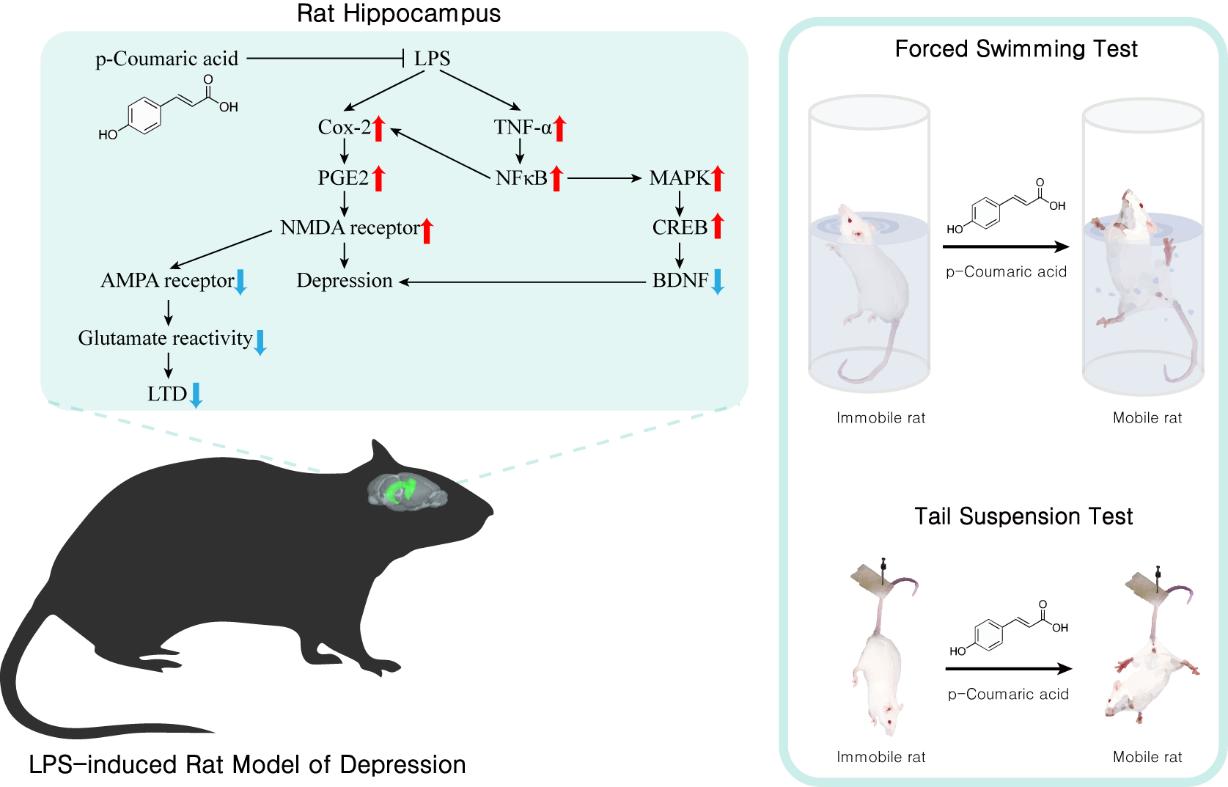To Evaluate Antidepressant Effect of Indomethacin in Mice with IFN Alpha-Induced Depression
Uncategorized Uncategorized
To Evaluate Antidepressant Effect of Indomethacin in Mice with IFN Alpha-Induced Depression
Introduction
The current work used an IFN-α-induced depression model in albino mice to examine the antidepressant properties of indomethacin. To assess the antidepressant impact of a particular medicine on albino female albino mice following stress induction, several tests were performed on them, including locomotor activity, splash test, forced swimming test, tail suspension, sucrose preference, and open field testing. The time when you’re not moving % preference for sucrose solution in the TST was noted. The antioxidant capability was evaluated by tracking the levels of reduced glutathione (GSH), catalase (CAT) activity, and malondialdehyde (MDA) in the brain. Animals that took indomethacin during the TST remained immobile for much shorter periods of time than the stressed group. Treatment with indomethacin increased the percentage of patients who preferred sucrose solution, bringing them closer to the standard antidepressant amitriptyline. Moreover, Indomethacin significantly decreased plasma
The most prevalent affective illness, which is defined as a mood disorder as opposed to a thought or cognitive disorder, is depression. It can manifest in a variety of ways, from extremely mild situations that are almost normal to severe (psychotic) depression that is accompanied by delusions and hallucinations (Gupta et al., 2015). The emotional signs and symptoms of depression that are described
According to the Diagnostic and Statistical Manual of Mental Disorders, the physical symptoms of depression include headaches, pain, sleep disorders, changes in appetite, gastrointestinal issues, and changes in psychomotor function. The psychological symptoms of depression include sadness, guilt, and suicidal thoughts. The World Health Organization International Consortium of Psychiatric Epidemiology (WHO ICPE) estimates that between 6.3 and 15.7% of people worldwide experience depression at some point in their lives. Moreover, 7–12% in males and 20The drug indomethacin (IND) belongs to the group of drugs known as NSAIDs. Because indomethacin prevents prostaglandin synthesis, it has certain effects. Cyclooxygenase (COX) enzymes are the main producers of prostaglandins, which are important mediators of pain, fever, and inflammation (Munjal & Allam, 2022). MDD, or major depressive disorder Among the severe mental illnesses, mood disorders are the most prevalent type. Major depressive episodes can happen in both unipolar
Depression (where mood swings between euthymia and depression) and bipolar disorder (where mood swings between euthymia and depression as well as pathological “highs” called hypomania and mania). The DSM-5 defines major depressive episodes as a set of symptoms and signs (DSM-5, 2013). A number of vital functions, such as sleep, appetite, psychomotor activity, cognition, and, of course, mood, are altered in patients with major depression.
Indomethacin (IND)is used to treat osteoarthritis, rheumatoid arthritis, and ankylosing spondylitis-related moderate to severe pain, soreness, edema, and stiffness. Bursitis-related shoulder pain is also treated with indomethacin. Acute gouty arthritis is also treated with indomethacin suspension (liquid) and immediate-release pills. It functions by preventing the body from producing an agent that raises temperature, inflammation, and discomfort (Indomethacin: MedlinePlus Drug Information, 2021). According to reports, an IND dosage alone was able to
Acute toxicity study of Indomethacin
With minor adjustments, the technique described by Majeed R.K. et al. was used to assess the acute toxicity of indomethacin Acute toxicity in vivo was tested on albino mice. Mice received intraperitoneal injections of 5, 10, 20, 50, 100, and 200 mg/kg body weight of indomethacin, with a 24-hour observation period following each dose. The objective of this task involved determining the highest level of Indomethacin (IND) that organisms could safely consume (Al., 2018).
Cytokine Production and Regulation
Small proteins called cytokines can have an anti- or pro-inflammatory effect on the interactions and functions of cells. The cytokine families that perform specific roles are numerous. Immune cells, such as microglia in the central nervous system, are the main producers of cytokines, but other Cytokines are also produced by CNS cells, including neurons and astrocytes. Numerous factors, including genetics and prior pathogen exposure, influence immune activity, including cytokine production (MacGillivray and Kollmann, 2014). The most studied cytokines in the context of psychoneuroimmunology are interleukin (IL)-6, tumor necrosis factor (TNF), IL-1b, and interferons (IFNs) on the inflammatory side and IL-10 on the resolving side. Table 1 summarizes the cytokines and related molecules studied in the context of depression and lists
Induction of Depression
IFN alpha (IFN-α) cytokines were used to induce depression in the chosen animals because they have a high risk of adverse effects on the central nervous system. These consist of cognitive, neurovegetative, and mood symptoms (Capuron & Miller, 2004). For six days in a row, subcutaneous (SC) injections of INFα (16 × 105 IU/kg) body weight were administered (Mesripour et al., 2018). IFN alpha (IFN-α) cytokines were used to induce depression in the chosen animals because they have a high risk of adverse effects on the central nervous system. Mood, neurological, and cognitive symptoms are among them (Capuron & Miller, 2004). Body weight in INFα (16 × 105 IU/kg). was given six days in a row of subcutaneous (SC) injections (Mesripour et al., 2018).
NSAIDs in behavioral paradigm
To examine how NSAIDs affected the treated animals’ behavioral patterns, the animals underwent a variety of tests, including locomotor activity, splash activity, forced swimming, tail suspension, sucrose preference, and open field testing.
Locomotor activity
Using a photo actometer, the horizontal locomotor activity ratings of control and test animals were recorded for 5 min. Each mouse was maintained in the device for five minutes. If the mouse engaged in any exploratory behaviors, the light’s beam is interrupt, and the instrument automatically record the activity’s duration on its digital recorder. Digital recordings ceased recording as soon as the animal paused its activities (Dinesh Dhingra, 2012).
Splash test
This test was conducted with minor modifications from previous study by Sinigrin et al. It was performed under a red light (230 V, 15 W), consists of squirting a 10% sucrose solution on the dorsal coat of a mouse in its home cage. Because of its viscosity, the sucrose solution dirties the mouse fur and animals initiate grooming behavior. After applying sucrose solution, the time spent grooming was recorded for a period of 5 minutes as an index of self-care and motivational behavior. Grooming in rodents is an index of self-care and inspirational behavior that is alike some symptoms of depression such as passive behavior (Isingrini, Camus, Le Guisquet, et al., 2010).
Forced swimming test (FST)
This test was performed as an animal model of despair behaviour. Mice were forced to swim in 25 °C water in a glass beaker (diameter 12.5 cm, depth 12 cm) for 6 min. The immobility time was measured during the last 4 min of the trial. Swimming behaviour, defined as horizontal movement throughout the beaker which involved at least two limbs; and, immobility behaviour measured when no additional activity was observed other than that required to keep the animals’ head above the water. The whole experiment was recorded by a camera and analyzed later. After 6 min, the mice were dried carefully and returned to their home cage (Cryan et al)
Tail suspension test
Tail suspension test (TST) is another important behaviour test to measure the response on the stress situation. The rodent tails were suspended with adhesive tape to a horizontal bar for 6 minutes and the time of immobility was observed. If the subject shows more depressive-like behaviour, it will exhibit an increase in the amount of immobility time. To be noted, the TST is used only in mice, but not in rats due to the larger size and weight; in a majority of cases. TSTs are used to detect the antidepressant response (Wang et al., 2017) (Zaminelli et al., 2014)
Sucrose preference test
Animals were trained to consume sucrose solution while fasted for two days prior to exposing them to persistent mild stress. Three days later, after a 23-h fast, the animals were introduced to two bottles, one containing regular water and the other containing sucrose solution. The test was repeated after 21 days of therapy to ascertain the impact of therapy on the subjects’ preference for sucrose solution as a percentage, which will serve as an indicator for depression brought on by stress (Alsanie et al., 2022).
Open field test
Open field test is a commonly used model of anxiety-like behaviour developed to measure animal emotionality and is focused on subjecting an animal to an unfamiliar area whose escape is prevented by surrounding walls on 21st day of the experiment. The open-field box is used in this, which is a rectangular area consisting of a hard floor measuring 60 cm × 60 cm × 40 cm and made of white painted wood. The floor was split into 16 equal squares at the bottom using permanent read markings, placed each rat individually in one corner of the field, and recorded the total locomotion and rearing frequency for each 10-minute cycle. After each of these assays, to remove olfactory bias, the area was cleared with 70 per cent alcohol and the area allowed drying out before adding a fresh rat (Ekeanyanwu et al., 2021).
Sucrose preference test
Effect of NSAIDs in Biochemical Parameters
The following biochemical parameters were evaluated in addition to the effect of NSAIDs on those parameters.
Determination of SOD enzyme activity
Using the SOD Assay Kit-WST, the amount of SOD enzyme activity in PC12 cells was determined. Following the specified times pan of incubation of the PC12 cells with the experimental reagents, the 96-well plates’ original medium was eliminated, and the PC12 cells were lysed using Nonidet P-40 lysis buffer (1% NP-40, 50 mmol/L Tris-HCl).
Ethylenediamine tetra-acetate (0.05 mmol/L, pH 7.5) for 20 minutes at 4°C. After centrifuging the lysates at 300 g for 10 minutes, 20 µL of the sample solution was used to measure the activity of the SOD enzyme. The percentage of control was calculated using the values for each treatment group (Kolla et al., 2005).
Biochemical parameters estimation in Plasma
On day 23, blood was drawn, and the plasma was separated using a centrifuge so that corticosterone and nitrite could be measured. This was carried out sixty minutes following the administration of treatment (Alsanie et al., 2022).
Biochemical Estimations in Brain Homogenate
On the 23rd day, the mice were decapitated, and their brains were isolated after blood samples were taken. The obtained brain samples were washed with cold buffer (pH 7.4) consisting of 0.25 M sucrose, 0.1 M Tris, and 0.02 Methylenediamine tetra acetic acid. The brain samples were centrifuged. The concentrations of catalase, reduced glutathione, and oxidative stress markers, malondialdehyde (MDA), an indication of lipid peroxidation in animal tissues were measured in the centrifuged supernatant. The MDA (Malondialdehyde) level, reduced glutathione, and catalase activity were determined by reported procedures (Greenwald, 2018; Jollow D.J., 1974; Wills, 1965) respectively, using UV–visible spectrophotometers (Alsanie et al., 2022). For the assay of Brain Monoamine oxidase (Mono-A) activity, Monoamine oxidase A assay kit (Sigma Aldrich) was used.
Statistical Analysis
Each group contained six animals, which were utilised to gather the data for the analysis. A one-way analysis of variance (ANOVA) and the Dunnett’s test were used to assess the data (Graphpad Prism 9.0, San Diego, CA, USA). The data in the tables were expressed as mean ± SEM, and differences were deemed significant when the p-value difference between groups was less than 0.05
References
1. Al., R.K.M. et. al (2018). Acute Toxicity Study of Indomethacin and Oxytetracycline in Rabbits Rebin. Medical Journal of Babylon, 117–121. https://doi.org/10.4103/MJBL.
2. Alsanie, W. F., Alamri, A. S., Abdulaziz, O., Salih, M. M., Alamri, A., Asdaq, S. M. B., Alhomrani, M. H., & Alhomrani, M. (2022). Antidepressant Effect of Crocin in Mice with Chronic Mild Stress. Molecules, 27(17), 1–12. https://doi.org/10.3390/molecules27175462.
3. Capuron, L., & Miller, A. H. (2004). Cytokines and psychopathology: Lessons from interferon-α. Biological Psychiatry, 56(11), 819–824. https://doi.org/10.1016/J.BIOPSYCH.2004.02.009.
4. Cryan, J. F., Markou, A., & Lucki, I. (2002a). Assessing antidepressant activity in rodents: recent developments and future needs. TRENDSin Pharmacological Sciences, 23(5), 238–245.
5. Cryan, J. F., Markou, A., & Lucki, I. (2002b). Assessing antidepressant activity in rodents: recent developments and future needs. In TRENDS in Pharmacological Sciences (Vol. 23, Issue 5). http://tips.trends.com0165-6147/02/$-seefrontmatter.
6. De La Garza, R., & Asnis, G. M. (2003). The non-steroidal anti-inflammatory drug diclofenac sodium attenuates IFN-α induced alterations to monoamine turnover in prefrontal cortex and hippocampus. Brain Research, 977(1), 70–79. https://doi.org/10.1016/S0006-8993 (03)02757-4.
7. De, R., & Garza, L. (2003). IFN-induced depression: a role for NSAIDs. https://www.researchgate.net/publication/9017416.
8. Dinesh Dhingra, P.J.A.G.R.C. (2012). Possible involvement of monoaminergic neurotransmission in antidepressant-like activity of Emblica officinalis fruits in mice – PubMed. CNS Neurosci Ther. https://pubmed.ncbi.nlm.nih.gov/22070517.
9. Ekeanyanwu, R. C., Nkwocha, C. C., & Ekeanyanwu, C. L. (2021). Behavioural and biochemical indications of the antidepressant activities of essential oils from Monodora myristica (Gaertn) seed and Xylopia aethiopica (Dunal) fruit in rats. IBRO Neuroscience Reports, 10(August 2020), 66–74. https://doi.org/10.1016/j.ibneur.2021.01.001.
10. Fashi, Y. A., Mesripour, A., & Hajhashemi, V. (2017). Evaluation of the effect of soybean diet on interferon-α-induced depression in male mice. In Original Research Article (Vol. 7, Issue 5).
11. Franscina Pinto, E., & Andrade, C. (2016). Interferon-Related Depression: A Primer on Mechanisms, Treatment, and Prevention of a Common Clinical Problem. Current Neuropharmacology, 14(7), 743–748. https://doi.org/10.2174/1570159×14666160106155129.
12. Greenwald, R. A. (2018). Handbook methods for oxygen radical research. Handbook Methods for Oxygen Radical Research, 1–447. https://doi.org/10.1201/9781351072922.
13. Gupta, G., Jia Jia, T., Yee Woon, L., Kumar Chellappan, D., Candasamy, M., & Dua, K. (2015). Pharmacological Evaluation of Antidepressant-Like Effect of Genistein and Its Combination with Amitriptyline: An Acute and Chronic Study. Advances in Pharmacological Sciences, 2015. https://doi.org/10.1155/2015/164943.
14. GUZE, S. B. (2006). Diagnostic and Statistical Manual of Mental Disorders, 4th ed. (DSM-IV), 1228, 152(8), 1228–1228. Https://Doi.Org/10.1176/Ajp.152.8.
15. Indomethacin: MedlinePlus Drug Information. (2021). Https://medlineplus.gov/druginfo/ meds/a681027.

Amandeep
Assistant Professor, GIP, Geeta University
Related Posts

Artificial Intelligence: A Boon or Bane
Artificial Intelligence: A Boon or Bane Artificial Intelligence (AI) has emerged as one of the most transformative and controversial technologies of the 21st century. With its ability to process vast amounts of data, learn from experience, and perform complex tasks,
Future Reps: The 8 Fitness Trends Set to Dominate 2025
Future Reps: The 8 Fitness Trends Set to Dominate 2025 The fitness industry has always been dynamic, constantly evolving to reflect changes in technology, culture, and human behavior. What once centered primarily on lifting heavier weights, running faster, or

The Power of Effective Communication in University Success – Geeta University
The Power of Effective Communication in University Success – Geeta University Effective communication is a fundamental skill that plays a pivotal role in achieving success during university years and beyond. It encompasses the ability to express ideas, listen actively, collaborate


